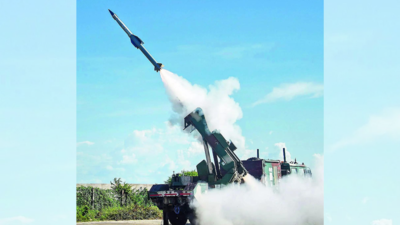NEW DELHI: The defence ministry will quickly take up the case for a preliminary nod to a Rs 30,000 crore proposal to acquire three regiments of the brand new indigenous fast response floor to air missile (QR-SAM) programs for the Military.The Rajnath Singh-led defence acquisitions council will take into account granting acceptance of necessity (AoN) for the highly-mobile QR-SAM programs, that are designed to intercept hostile fighters, helicopters and drones at a variety as much as 25-30 km, later this month.The transfer comes quickly after India’s present multi-layered air defence community performed a vital position in thwarting a number of waves of Turkish-origin drones and Chinese language missiles launched by Pakistan throughout Operation Sindoor – the Might 7-10 hostilities.The DRDO and the Military have over the past three-four years examined the QR-SAM programs in opposition to high-speed aerial targets mimicking varied forms of threats to guage their functionality underneath completely different day and night time operational eventualities. Defence PSUs Bharat Electronics and Bharat Dynamics will co-produce the QR-SAM programs.“The QR-SAM programs can function on the transfer with search and monitor functionality and fireplace at brief halts. They’re tailored to maneuver together with tanks and infantry fight automobiles to supply them air defence within the tactical battlefield,” an official mentioned.The Military Air Defence (AAD), which carried out exceedingly nicely throughout Operation Sindoor, in reality, requires 11 regiments of the QR-SAM, even because it progressively additionally inducts regiments of the indigenous Akash system, which has an interception vary of about 25-km at current.The induction of the QR-SAM programs will add to the present air defence community of the IAF and the Military, which ranges from the long-range Russian S-400 ‘Triumf’ surface-to-air missile programs (380 km interception vary) and Barak-8 medium vary SAM programs (70 km), collectively developed with Israel, to the Russian shoulder-fired Igla-S missiles (6 km), the upgraded L-70 anti-aircraft weapons (3.5 km) and the indigenous built-in drone detection and interdiction programs (1km-2 km).Whereas the DRDO can be readying the very short-range air defence missile programs (VSHORADS), which have a 6 km interception vary, the actual game-changer will probably be an air defence system with a 350 km vary being developed underneath the bold Mission Kusha.India plans to operationally deploy this long-range system by 2028-2029, with the defence ministry in Sept 2023 approving the AoN for procurement of 5 of its squadrons for the IAF at a price of Rs 21,700 crore, as was first reported by TOI.Additionally learn: India aims to deploy indigenous long-range air defence system by 2028-2029














